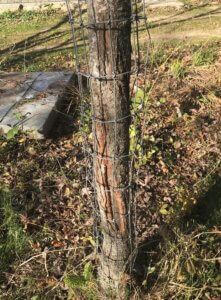As any gardener knows, winter can be tough on trees. The cold weather can damage the bark and leaves, and the lack of sunlight can weaken the tree’s overall health. One way to help protect young trees during the winter months is to provide them with stem protection. Wrapping the trunk in burlap or plastic helps to insulate it from the cold and prevents damage from snow and ice. In addition, placing a cone or cylinder around the trunk can help to prevent damage from animals that may try to take shelter in the tree. By taking these simple steps, you can help ensure that your young trees survive the winter months and thrive for years to come.
Table of Contents
Winter Stem Protection for Young Trees
How to Protect Your Tree in Winter
Protecting Young Trees from Winter Hazards
Towards the end of winter, two things start to happen: sunlight gets stronger, and food starts to run out for many of our furry four-legged friends. Though these issues are unrelated, the damage that results can cause the same problem: areas of damaged or dead tissue on the trunk, which can lead to stunted growth, defective trunks, and even death of the tree. Once this damage occurs there’s much less we can do for the tree, so we should focus on preventing the damage in the first place. Understanding how this damage takes place is crucial to know how best to prevent it.
How to Protect Your Tree From Sunlight Damage

When warm, bright sunlight hits the trunk and branches of a tree, it can heat up the bark to the point that the bark begins to break dormancy. This is part of the normal process of trees waking up from the long cold winter. However, if air temperatures are still below freezing the bark can refreeze without hardening off. This can lead to damage or death of the bark and cambium layer, creating a sunken wound on the trunk. Over time the tree may be able to grow over and seal the wound, but often these wounds are never fully closed.
To prevent this damage from occurring, we need to make sure the tissue never warms up in the first place. To do this, we need to keep light off the bark. We can do this by wrapping or covering the main trunk with a material that blocks light. Ideally, this wrap would be white or a light color to reflect as much light and heat up as little as possible.
Wraps come in several materials, for wrapping trunks to prevent sunscald we recommend white polypropylene. No matter the material, trees should only be wrapped for the winter to avoid girdling the trunk or having rot develop. We recommend wrapping after the leaves drop in the fall and removing at bud break in the spring, Thanksgiving to St Patrick’s Day is a good rule of thumb.
How to Protect Your Tree From Animals

The other main culprit we need to be prepared for is the unwanted attention of animals. When all the easy, more nutritious food is gone, rabbits will begin feeding on the thin bark of young trees. They can strip off all the bark they can reach, leading to extensive girdling and even eventual death of the tree. Deer rubbing their antlers on trees can also cause significant damage. Trees with trunk damage will often leaf out for several years after damage occurs, but if the wound is too large and the connection between the leaves and roots isn’t re-established eventually the roots will die of starvation.
To protect the bark from animals, we need to provide a strong physical barrier. This can consist of wrapping the trunk with tree wrap or wire mesh. If we’re protecting against feeding, the holes in the mesh should be small: ½” or less. Wrapping for deer protection should only be done with wire mesh but can have much larger holes. If caging further away, well-supported chicken wire with larger holes can work as well.
It’s important to account for snowpack when determining how high to wrap or how tall to make cages, significant snow accumulation can quickly render these measures ineffective. Wire mesh can be left on trunks year-round to protect against animals but should be checked annually for girdling and adjusted if needed.
Young trees can face many obstacles during their first years in the landscape, we can take some simple steps to help avoid these issues.

